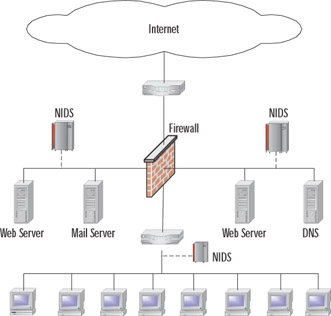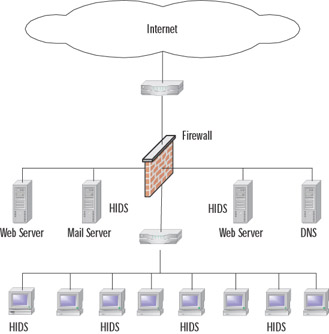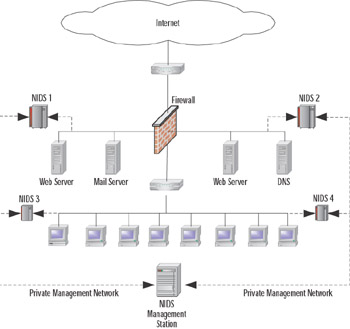What Is Intrusion Detection?
|
Webster's dictionary defines an intrusion as "the act of thrusting in, or of entering into a place or state without invitation, right, or welcome." When we speak of intrusion detection, we are referring to the act of detecting an unauthorized intrusion by a computer on a network. This unauthorized access, or intrusion, is an attempt to compromise, or otherwise do harm, to other network devices.
An Intrusion Detection System (IDS) is the high-tech equivalent of a burglar alarm—a burglar alarm configured to monitor access points, hostile activities, and known intruders. The simplest way to define an IDS might be to describe it as a specialized tool that knows how to read and interpret the contents of log files from routers, firewalls, servers, and other network devices. Furthermore, an IDS often stores a database of known attack signatures and can compare patterns of activity, traffic, or behavior it sees in the logs it is monitoring against those signatures to recognize when a close match between a signature and current or recent behavior occurs. At that point, the IDS can issue alarms or alerts, take various kinds of automatic action ranging from shutting down Internet links or specific servers to launching backtraces, and make other active attempts to identify attackers and actively collect evidence of their nefarious activities.
By analogy, an IDS does for a network what an antivirus software package does for files that enter a system: It inspects the contents of network traffic to look for and deflect possible attacks, just as an antivirus software package inspects the contents of incoming files, e-mail attachments, active Web content, and so forth to look for virus signatures (patterns that match known malware) or for possible malicious actions (patterns of behavior that are at least suspicious, if not downright unacceptable).
To be more specific, intrusion detection means detecting unauthorized use of or attacks on a system or network. An IDS is designed and used to detect and then to deflect or deter (if possible) such attacks or unauthorized use of systems, networks, and related resources. Like firewalls, IDSs can be software based or can combine hardware and software (in the form of preinstalled and preconfigured stand-alone IDS devices). Often, IDS software runs on the same devices or servers where firewalls, proxies, or other boundary services operate; an IDS not running on the same device or server where the firewall or other services are installed will monitor those devices closely and carefully. Although such devices tend to operate at network peripheries, IDSs can detect and deal with insider attacks as well as external attacks.
IDSs vary according to a number of criteria. By explaining those criteria, we can explain what kinds of IDSs you are likely to encounter and how they do their jobs. First and foremost, it is possible to distinguish IDSs by the kinds of activities, traffic, transactions, or systems they monitor. IDSs can be divided into network-based, host-based, and distributed. IDSs that monitor network backbones and look for attack signatures are called network-based IDSs, whereas those that operate on hosts defend and monitor the operating and file systems for signs of intrusion and are called host-based IDSs. Groups of IDSs functioning as remote sensors and reporting to a central management station are known as Distributed IDS (DIDS).
In practice, most commercial environments use some combination of network, and host, and/or application-based IDS systems to observe what is happening on the network while also monitoring key hosts and applications more closely. IDSs can also be distinguished by their differing approaches to event analysis. Some IDSs primarily use a technique called signature detection. This resembles the way many antivirus programs use virus signatures to recognize and block infected files, programs, or active Web content from entering a computer system, except that it uses a database of traffic or activity patterns related to known attacks, called attack signatures. Indeed, signature detection is the most widely used approach in commercial IDS technology today. Another approach is called anomaly detection. It uses rules or predefined concepts about "normal" and "abnormal" system activity (called heuristics) to distinguish anomalies from normal system behavior and to monitor, report on, or block anomalies as they occur. Some anomaly detection IDSs implement user profiles. These profiles are baselines of normal activity and can be constructed using statistical sampling, rule-base approach or neural networks.
Literally hundreds of vendors offer various forms of commercial IDS implementations. Most effective solutions combine network- and host-based IDS implementations. Likewise, the majority of implementations are primarily signature based, with only limited anomaly-based detection capabilities present in certain specific products or solutions. Finally, most modern IDSs include some limited automatic response capabilities, but these usually concentrate on automated traffic filtering, blocking, or disconnects as a last resort. Although some systems claim to be able to launch counterstrikes against attacks, best practices indicate that automated identification and backtrace facilities are the most useful aspects that such facilities provide and are therefore those most likely to be used.
IDSs are classified by their functionality and are loosely grouped into the following three main categories:
-
Network-Based Intrusion Detection System (NIDS)
-
Host-Based Intrusion Detection System (HIDS)
-
Distributed Intrusion Detection System (DIDS)
Network IDS
The NIDS derives its name from the fact that it monitors the entire network. More accurately, it monitors an entire network segment. Normally, a computer network interface card (NIC) operates in nonpromiscuous mode. In this mode of operation, only packets destined for the NICs specific media access control (MAC) address are forwarded up the stack for analysis. The NIDS must operate in promiscuous mode to monitor network traffic not destined for its own MAC address. In promiscuous mode, the NIDS can eavesdrop on all communications on the network segment. Operation in promiscuous mode is necessary to protect your network. However, in view of emerging privacy regulations, monitoring network communications is a responsibility that must be considered carefully.
In Figure 4.1, we see a network using three NIDS. The units have been placed on strategic network segments and can monitor network traffic for all devices on the segment. This configuration represents a standard perimeter security network topology where the screened subnets on the DMZ housing the public servers are protected by NIDSs. When a public server is compromised on a screened subnet, the server can become a launching platform for additional exploits. Careful monitoring is necessary to prevent further damage.

Figure 4.1: NIDS Network
The internal host systems inside the firewall are protected by an additional NIDS to mitigate exposure to internal compromise. The use of multiple NIDS within a network is an example of a defense-in-depth security architecture.
Host-Based IDS
HIDS differ from NIDS in two ways. HIDS protects only the host system on which it resides, and its network card operates in nonpromiscuous mode. Nonpromiscuous mode of operation can be an advantage in some cases, because not all NICs are capable of promiscuous mode. In addition, promiscuous mode can be CPU intensive for a slow host machine. HIDS can be run directly on the firewall as well, to help keep the firewall secure.
Another advantage of HIDS is the ability to tailor the ruleset to a specific need. For example, there is no need to interrogate multiple rules designed to detect DNS exploits on a host that is not running Domain Name Services. Consequently, the reduction in the number of pertinent rules enhances performance and reduces processor overhead.
Figure 4.2 depicts a network using HIDS on specific servers and host computers. As previously mentioned, the ruleset for the HIDS on the mail server is customized to protect it from mail server exploits, while the Web server rules are tailored for Web exploits. During installation, individual host machines can be configured with a common set of rules. New rules can be loaded periodically to account for new vulnerabilities.

Figure 4.2: HIDS Network
Distributed IDS
The standard DIDS functions in a Manager/Probe architecture. NIDS detection sensors are remotely located and report to a centralized management station. Attack logs are periodically uploaded to the management station and can be stored in a central database; new attack signatures can be downloaded to the sensors on an as-needed basis. The rules for each sensor can be tailored to meet its individual needs. Alerts can be forwarded to a messaging system located on the management station and used to notify the IDS administrator.
In Figure 4.3, we see a DIDS system comprised of four sensors and a centralized management station. Sensors NIDS 1 and NIDS 2 are operating in stealth promiscuous mode and are protecting the public servers. Sensors NIDS 3 and NIDS 4 are protecting the host systems in the trusted computing base. The DIDS are on the outside of the firewall, usually on the DMZ or outside.

Figure 4.3: DIDS Network
The network transactions between sensor and manager can be on a private network, as depicted, or the network traffic can use the existing infrastructure. When using the existing network for management data, the additional security afforded by encryption, or VPN technology, is highly recommended.
In a DIDS, complexity abounds. The scope and functionality varies greatly from manufacturer to manufacturer, and the definition blurs accordingly. In a DIDS, the individual sensors can be NIDS, HIDS, or a combination of both. The sensor can function in promiscuous mode or nonpromiscuous mode. However, in all cases, the DIDS' single defining feature requires that the distributed sensors report to a centralized management station.
|
EAN: 2147483647
Pages: 240